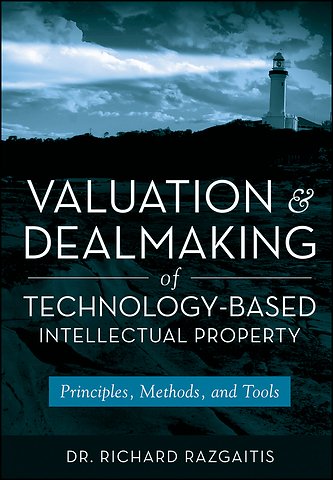Valuation and Dealmaking of Technology-Based Intellectual Property
Principles, Methods and Tools
Samenvatting
Commercializing technology inno vation is no risk free journey. But as technology licensing expert Richard Razgaitis thoroughly explains, by applying reasoned judgment and proven approaches, methods, and tools, you can profitably succeed in risk based opportunity. Essential reading for licensing executives, M&A dealmakers, technology startups, and intellectual property consultants and attorneys, Valuation and Dealmaking of Technology Based Intellectual Property shows you how.
This new book a completely revised and expanded edition of Razgaitis s previous book Valuation and Pricing of Technology Based Intellectual Property brings together material designated as "Approaches" into three core technology business processes used for transforming technology into money: opportunity Discovery, Valuation, and Dealmaking, or the acronym D V D. In addition, this book introduces, develops, and applies the following six valuation methods:
-Use of Industry Standards for Valuation
-
The Rating/Ranking Method, and Tool
-
Rules of Thumb to Determine Valuation
-
Discounted Cash Flow Method to Determine Valuation
-
Advanced Valuation Methods
-
Valuation by Auctions
The use of Monte Carlo as an Advanced Valuation method has also been expanded in this new edition and an accompanying Web site, www.razgaitis.com, provides spreadsheets used in this book as well as a link to a free trial of the Monte Carlo software to allow professionals to run their own simulations.
Guiding licensing executives through world class techniques on how to transform a technology opportunity into a reason based valuation and consummated license/sale, Valuation and Dealmaking of Technology Based Intellectual Property provides the critical guidance licensing professionals need.
Specificaties
Inhoudsopgave
Disclaimer.
About the Author.
Acknowledgments.
CHAPTER 1 Introduction to Opportunity Discovery, Valuation, and Dealmaking.
Introduction: Technology D V D.
Taxonomy of Technology Licensing.
High Significance, High Ambiguity Contexts.
Licensing D V D and Innovation.
Going Forward.
Notes.
CHAPTER 2 Risk and Reward.
Uncertainty.
Phronesis (Judgment).
Technology Uncertainty.
More on Risk.
Value and Price.
Two Final Points on Buying and Selling.
Notes.
APPROACH I OPPORTUNITY DISCOVERY.
CHAPTER 3 Identifying and Prioritizing Technology Opportunities.
Seller "Opportunity Space".
The Technology Box.
Buy Side Expressions of Value: The Wheelbarrow.
Overview of Valuation Methods.
The Six Valuation Methods.
Conclusion.
Notes.
APPROACH II VALUATION.
CHAPTER 4 Method 1: Use of Industry Standards for Valuation.
The Concept and Limitations of "Industry Standards".
Sources of Industry Standard Data and Information.
Survey Results as a Source of Industry Standards Data and Information.
Proposed or Established Norms.
Shopped Term Sheets and Price Lists.
News Sources of License Agreement Information.
Journals, Proprietary Databases, Reports, and Consultants.
Published License Agreements as a Source of Industry Standards.
Court Cases/Judgments as a Source of Industry Standards.
Patent Pools.
Lifetime and Organizational Learning.
Average Error.
Concluding Observations and Cautionary Notes.
Appendix 4A: Outline of Agreement between DuPont and University of Houston.
Notes.
CHAPTER 5 Method 2: The Rating/Ranking Method, and Tool.
Ubiquity of Rating/Ranking.
Overview of How Rating/Ranking Can Be Used in Valuation.
Groups and Grouping as a Fundamental Knowledge Forming Process.
Using Rating/Ranking to Value Technology: Factor Assessment.
Developing Criteria for Using Rating/Ranking for Valuation of Technologies.
Illustrations of Applying the Rating/Ranking Method.
Issues in Interpreting Value from a Rating/Ranking Result.
Using Rating/Ranking to Value Technology: Classified Value.
Uses of Rating/Ranking with Approaches and as a General Tool.
Perspectives on Rating/Ranking as an Approach with Licensing.
Knowledge, Uncertainty, and Humility.
Conclusion.
Appendix 5A: Factors in Pricing License.
Notes.
CHAPTER 6 Method 3: Rules of Thumb to Determine Valuation.
Foundations of Rules of Thumb.
Cost Savings Example of the 25 Percent Rule.
Perspectives on the 25 Percent Rule.
Use of the 25 Percent Rule for Apportioning New Profits.
Examples of Applying the 25 Percent Rule to New Profits Licensing.
A Universal Rule of Thumb Chart.
Other Percent Rule Values.
Some Misuses/Misapplications of the 25 Percent Rule.
Other Valuation Rules of Thumb Used (or Have Been Proposed).
Summary Points on the Use of the 25 Percent Rule.
Conclusion.
Notes.
CHAPTER 7 Method 4: Discounted Cash Flow Method to Determine Valuation.
Overview of the DCF Method.
Basic Financial Concepts.
Quantification, Classification of Risk.
An Example Cash Flow Projection from a License.
Additional Considerations for Calculating DCF.
Segment and Scenario Analysis.
Cash Flow Projections.
Other Issues to Be Considered with the DCF Method.
Conclusion.
Sources of Information to Develop Business Projections.
Notes.
CHAPTER 8 Method 5: Advanced Valuation Methods.
Modified Discounted Cash Flow Method.
Monte Carlo Method.
Real Option Methods.
Conclusion.
Online Resources.
Appendix 8A: Example Crystal Ball Report for Exhibit 8.18.
Appendix 8B: Crystal Ball Report Corresponding to the Results Presented in Exhibit 8.XX for a Double Humped Cost Distribution Assumption.
Notes.
CHAPTER 9 Method 6: Valuation by Auctions.
Introduction to Auctions.
When Auctions are Feasible.
Auction Examples.
Auctions as Distinct from Other Types of Dealmaking.
Auction Strategies for Buyers.
Auction Caution.
Conclusion.
Appendix 9A: Bidder s Agreement.
Notes.
APPROACH III DEALMAKING.
CHAPTER 10 Approach: Deal Structure.
Return to the Box and Wheelbarrow.
Cash When Pricing Structures.
Cash As Pricing Structures.
Cash If Pricing Structures.
Cash Maybe: Options.
Consideration Forms Beyond Simple Cash.
Special Form of Cash If: Equity.
Balancing Simplicity with Comprehensiveness.
Conclusion.
Notes.
CHAPTER 11 People, Process, and Lessons Learned.
Introduction.
Deal Team.
Deal Targets.
Negotiating Plan.
Plan B.
Concluding Advice from Technology Dealmakers.
Notes.
CHAPTER 12 In Conclusion.
Approach of Opportunity Discovery as a Quest.
Approach of Valuation: A Review of the Six Valuation Methods.
Approach of Dealmaking.
Closing Thoughts.
Website Resources.
Notes.
Appendix: List of Abbreviations and Trademarks.
Bibliography.
Index.
Anderen die dit boek kochten, kochten ook
Net verschenen
Rubrieken
- aanbestedingsrecht
- aansprakelijkheids- en verzekeringsrecht
- accountancy
- algemeen juridisch
- arbeidsrecht
- bank- en effectenrecht
- bestuursrecht
- bouwrecht
- burgerlijk recht en procesrecht
- europees-internationaal recht
- fiscaal recht
- gezondheidsrecht
- insolventierecht
- intellectuele eigendom en ict-recht
- management
- mens en maatschappij
- milieu- en omgevingsrecht
- notarieel recht
- ondernemingsrecht
- pensioenrecht
- personen- en familierecht
- sociale zekerheidsrecht
- staatsrecht
- strafrecht en criminologie
- vastgoed- en huurrecht
- vreemdelingenrecht







